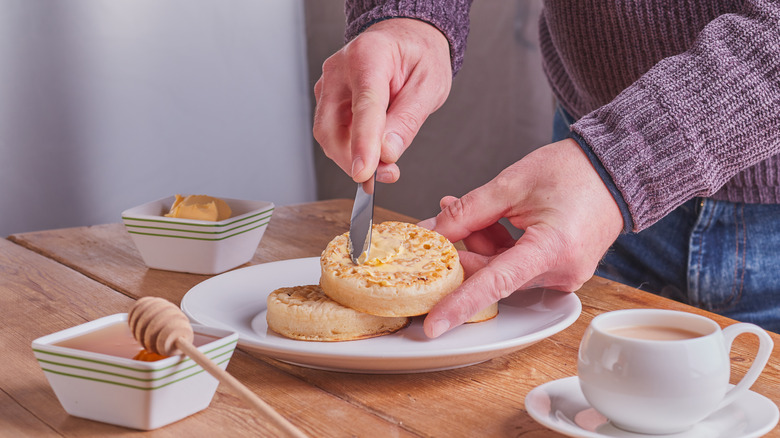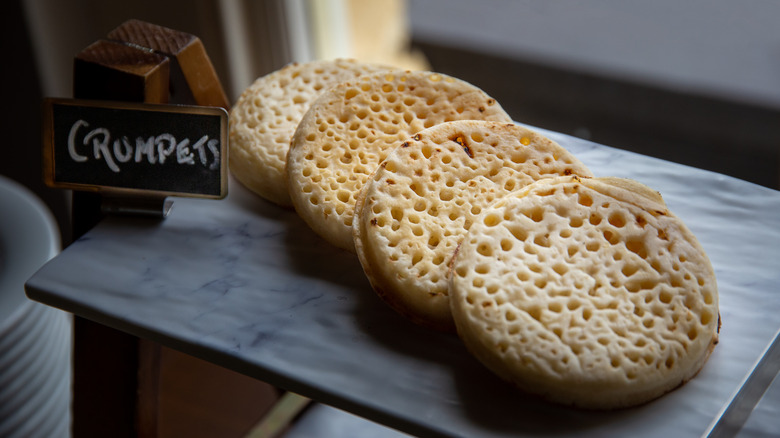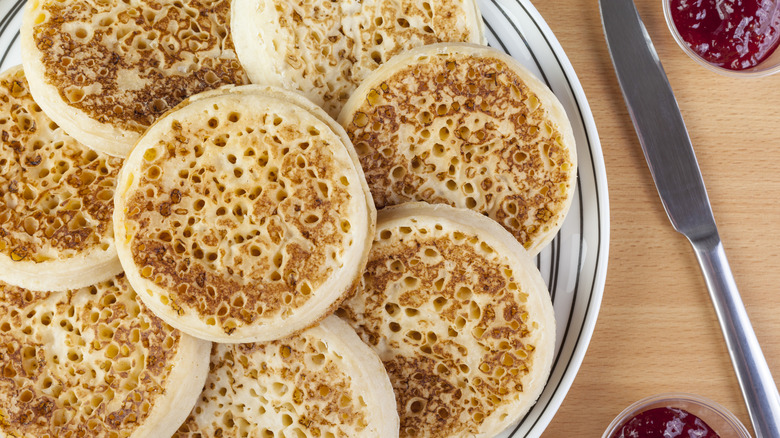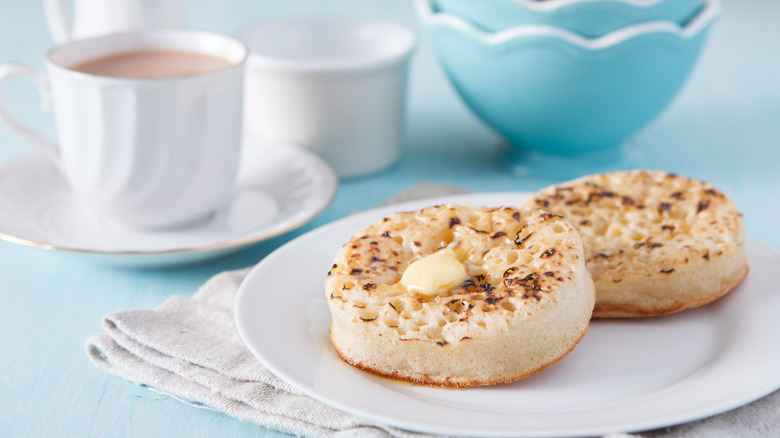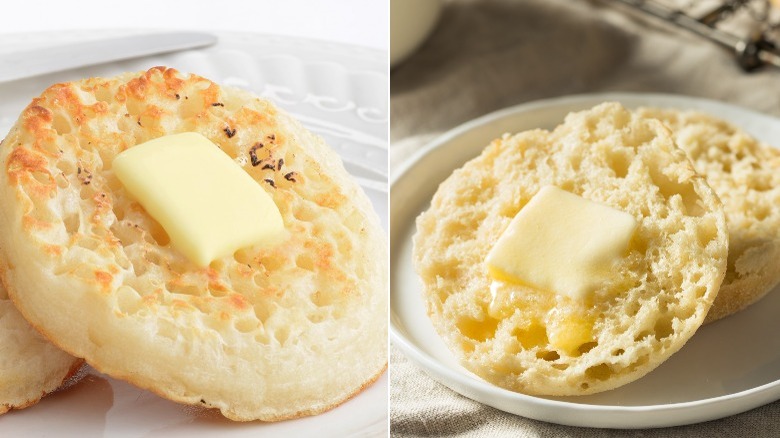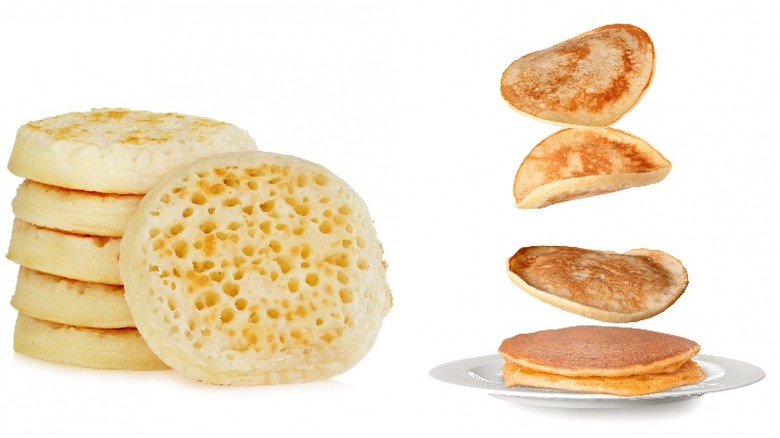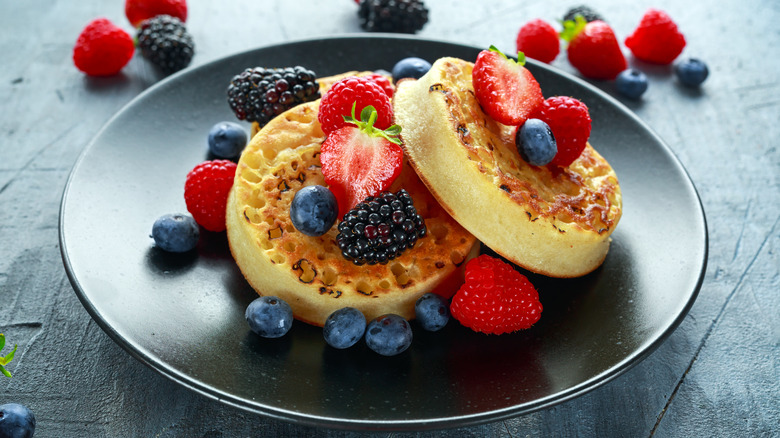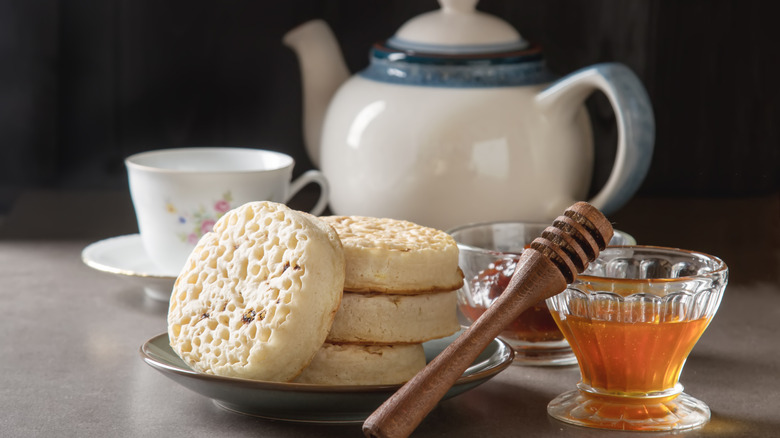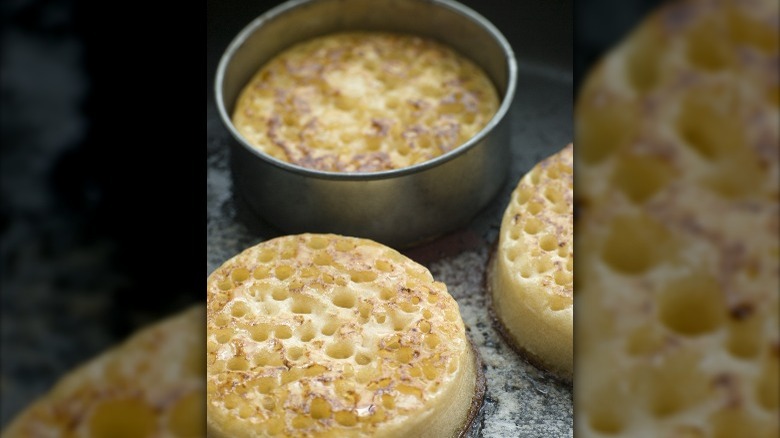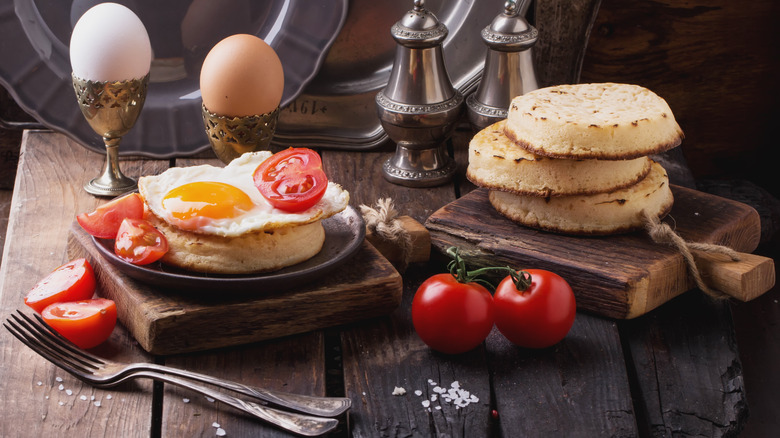The Untold Truth Of Crumpets
We've all heard of tea and crumpets, but apart from being achingly British, what exactly does that entail, and what on earth is a crumpet? If you think it sounds like something her ladyship might partake in on an episode of Downton Abbey, you're right, but that's not the whole story.
The British are internationally famous for their love of tea and crumpets, likely spreading their enthusiasm for the duo throughout the formerly vast British empire. As Crumpet Man explains, crumpets and their ancestors have been popular as everyday food in the British Isles for centuries. However, on the other side of the Atlantic, crumpets are often confused with everything from English muffins to pancakes. The confusion might be in part due to the fact that they're not usually available in regular grocery stores in America.
Fortunately, these British treats are easy to make at home, and they're not just for teatime. If you love all manner of breakfast foods, then read on to learn everything there is to know about crumpets.
What is a crumpet?
According to Britannica, crumpets are a spongy type of griddle cake, made from batter and cooked in a flat pan. The batter is made with yeast, sugar, flour, baking soda, and milk, then poured into special crumpet rings on a griddle and cooked from the bottom up until it rises and forms a spongy top. Crumpets are crisp on the bottom, soft and chewy on the top, and delicious from every angle.
As Crumpet Man notes, the treats are first mentioned in 1382 in the work of theologian John Wycliffe, described as flat cakes cooked on a hot stone. Early crumpets were often made with buckwheat flour, and the fluffy leavened version we know and love today is attributed to the Victorian era, when ring molds were also introduced. Contrary to our idea of the classic tea and crumpets narrative, crumpets were enjoyed by people of all social classes, eaten off the fine bone china plates of the aristocracy as well as by regular working folk.
Where does the name crumpet come from?
In the United States, crumpets are often confused with English muffins but we're here to set that straight. The two are totally different, albeit equally delicious carb-based delights. Per Crumpet Man, in John Wycliffe's translation of the Latin Old Testament in 1382, he first wrote of a crompid or crumpled cake. The word crump, from which crumpled is also derived, once meant crooked or bent (per Etymology Geek), so the theory goes that the flat crompid cake got its name from the way the edges curled up crookedly as it cooked on a hot stone. Given the centuries, it's not hard to see the linguistic progression from crompid to crumpet.
Although we don't know exactly what other moves the crumpet made along the way, what is known is that when Elizabeth Raffald's "The Experienced Housekeeper" was published in 1769, it included a recipe titled "To make Tea Crumpets." Her recipe called for eggs, which have been eliminated in modern crumpets, but otherwise, Raffald's crumpets are recognizable as the ancestors of a great teatime treat.
A word to the wise: Newly minted crumpet lovers should note that in the United Kingdom, a crumpet is also slang for an attractive woman per Dictionary.com, and should therefore be used with caution.
Where are crumpets eaten?
As a thoroughly British invention, it is no surprise that crumpets are eaten worldwide in many former colonies, including New Zealand, Australia, Canada, and the United States (per Crumpet Man). In the U.K., the most famous crumpet manufacturer is Warburtons, a family-run business that has been baking the good stuff since 1876. From supermarkets to cafés, crumpets are interchangeable with toast, and they are served at any time of day or night, especially for breakfast.
Meanwhile, in the United States, it can be difficult to find crumpets in an ordinary supermarket. Some cities have specialty stores that stock imported goods from the U.K., and many of them sell online too. There are also several American bakeries that make and sell English crumpets, shipping the treats all over the country. Although you might have to dig a bit, it is possible to get your crumpet fix in the States without having to bake them yourself.
Crumpets vs. English muffins
They're both English and you eat them for breakfast –- so what's the real difference between a crumpet and an English muffin? Curiously, despite being named after England, the English muffin was actually invented in America. According to Gordon Ramsay's MasterClass, the English muffin was created in 1880 in New York City by Samuel Bath Thomas, a British expat who was missing the taste of his homeland's crumpet. As a result, the toaster crumpet, or English muffin, was born. Thomas' baking company survives to this day, making original English muffins for satisfied customers.
Although Thomas created an entirely new product, both English muffins and crumpets incorporate air bubbles which gives them the ideal texture to be vehicles for butter, jam, eggs, melted cheese, and so on. Where they differ is that crumpets are made out of batter poured into ring molds, while English muffins are made from dough. Additionally, crumpets are only cooked on one side, while English muffins are cooked on both sides since they're thicker. For this reason, English muffins are usually split in half before being toasted and eaten. The contrast between batter and dough creates a clear difference in taste and texture: Crumpets are chewy, whereas English muffins are crispier and doughy.
Crumpets vs. Pancakes
Crumpets and pancakes fulfill a similar role as delicious hot treats, preferable at breakfast. They also contain similar ingredients, and although you can put fruit jam on a crumpet and bacon on a pancake, in general crumpets tend toward the savory, while pancakes are typically sweet. In fact, the actual issue comes from figuring out what to call round carb-based breakfast foods.
As Crumpet Man explains, in the United Kingdom the word crumpet is regional. In the English Midlands and some parts of Northern England, a similar item named pikelet is served. These are much flatter than crumpets because the batter is poured straight onto the griddle instead of being poured into a crumpet ring. Pikelets can be traced back to Wales, where they were originally called bara pyglyd. If that wasn't confusing enough, in Australia and New Zealand, the term pikelet refers to a small pancake, like an American silver dollar pancake, but Scottish pancakes (which are very similar to American pancakes) are often called crumpets in Scotland.
Perhaps the simplest way to delineate crumpets, pikelets, and pancakes is through the ingredients: crumpets (sometimes known as pikelets) contain yeast and no eggs, while both pikelets and pancakes (sometimes known as crumpets) contain eggs and no yeast. Still lost? Well, at least they're all delicious, even if you're not quite sure what you're ordering.
Are crumpets healthy?
We've said it before, and we'll say it again –- every food is healthy if it's part of a balanced diet! That said, there are some foods that have more of a nutrient-dense profile than others. So how do crumpets stack up?
Store-bought versions are likely to be high in salt, and one Warburtons crumpet contains 14% of your daily sodium intake (via Tesco). On the other hand, they're very low in fat, so feel free to add as much butter as you like; remember, fat is important because it keeps you feeling full for longer. As far as fiber intake, you'd probably be better off with a piece of wholegrain bread.
If you want a healthier crumpet combination to enjoy as a regular breakfast or snack, try topping it with high-protein ingredients, like peanut butter or an egg. As well, serving them with fresh fruit is a great way to add extra vitamins. Crumpets on their own are pretty low in calories, and we recommend eating at least two at a time for your health. Not just because they're tasty.
The story of tea and crumpets
The storied British tradition of afternoon tea actually only dates back to the mid-19th century, according to Historic UK. The story goes that Anna, 7th Duchess of Bedford, found herself getting hungry in the long afternoon between her noontime luncheons and an 8 p.m. dinnertime (definitely relatable). Therefore, she had her staff bring her tea, sandwiches, and cake around 4 p.m. every day, eventually asking friends over to join. Scones, cookies, bread and butter, toast, and of course crumpets became traditional accompaniments for afternoon tea.
But how did tea and crumpets become so intertwined? It's definitely true that a nice hot cup of tea is a great match for a warm, buttery toasted crumpet, particularly if it's raining outside (as it regularly does in the U.K.). Then again, the British think a cup of tea is the perfect pairing for every activity. Either way, any excuse to fit an extra snack into the day is fine by us.
How to make crumpets
Since crumpets may not be readily available in the United States (and by now you're probably desperate to try one), it's worth learning how to make your own. The good news is that making crumpets is not very difficult -– there's a reason they've been around for centuries!
Ideally, you should have crumpet ring molds or metal cookie cutters to cook the crumpets in (unless you want pikelets). If you don't have round molds, you can also make square, heart-shaped, or Christmas-tree-shaped crumpets –- just use whatever you have on hand. Aside from that, the only equipment you need is a cast-iron flat-bottomed pan (although a regular pan would probably do).
The Crumpet Man provides great tips and a recipe to successfully make your own crumpets. One essential step is to let the batter proof in order for the crumpets to rise properly and form delicious air bubbles that give them their great texture. Get creative and add flavorings to customize your crumpets as you please.
How to eat crumpets
If you like having a tasty dose of flavor with every bite, then crumpets are the perfect carbohydrate-based vehicle for your favorite jams, butter, and toppings. They can accommodate a huge variety of toppings, but it's important to remember that the texture –- thick, soft, chewy –- should come first. Thanks to the air holes, butter, honey, and jam easily soak through so that every bite oozes deliciousness. Melted butter is essential, which is probably why British doctrine dictates that crumpets are at their best served hot and toasted.
Per The Guardian, some people like to sprinkle a little salt on top of the butter to add a savory element. While a thin layer of jam or honey over the butter is nice, a slice of strong cheese on top is even better. Toasting your crumpet also gives you the opportunity to make an open-faced breakfast sandwich: think bacon, egg, tomato, or sausage for a heavenly start to the day.
